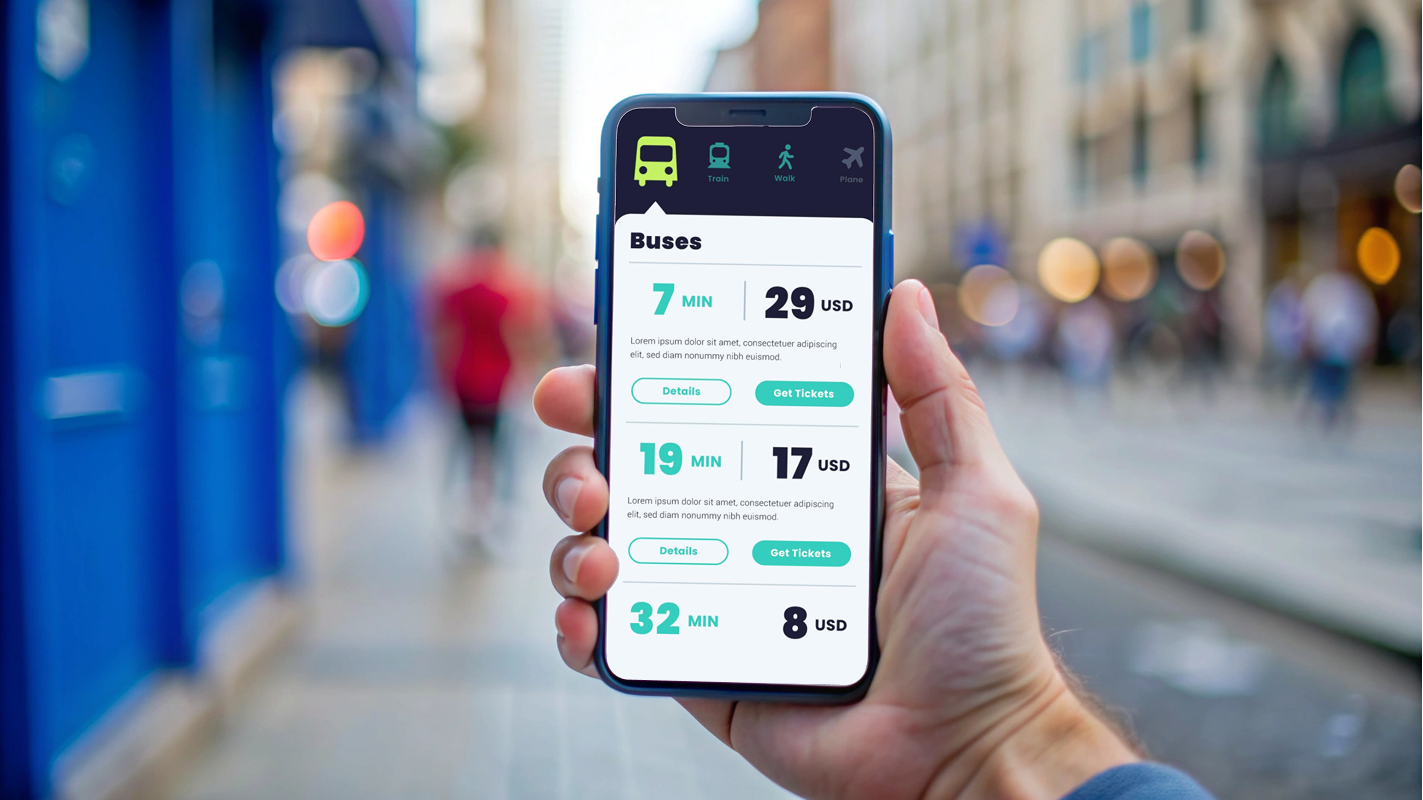
What is Mobility as a Service?
Mobility as a Service is a comprehensive solution that combines available mobility services in one application, allowing users to organize their trips in a more efficient and sustainable way. It is necessary to admit the increasing negative impact of the public transport sector on the environment while standing as the most energy-consuming sector worldwide. Additionally, the current urban mobility challenges also require convenient access to public transport services. Mobility as a service can contribute to positive transformation by improving the urban mobility experience through digital innovation, reduced costs, and optimized traffic flow.
How Mobility as a Service Is Redefining Urban Mobility
Compared to traditional modes of transportation, mobility as a service software introduces a single payment channel and application for travelers. Moreover, the solution is not limited to public transport as a MaaS operator can provide access to car rental, bike-sharing, and e-scooter services. The original mobility as a service business model further tackles the next transportation challenges:
- Economic Constraints: Despite the cross-financing and subsidies, a public transport system struggles to cover operating costs, becoming a financial burden for cities’ budgets. The emergence of mobility as a service market provides a cost-effective alternative that modernizes public mobility.
- Population Growth and Urbanization: With the increasing population growth, cities experience recurring congestion problems, resulting in transportation delays, rush hours, and hazards. In turn, mobility as a service business model provides sustainable alternatives to public transportation while reducing the workload with real-time optimization.
- Social Equity: Equitable access to transportation is a serious issue for highly urbanized areas as limited transportation planning decisions undermine quality of life and economic opportunities. By providing mobility as a service software, vulnerable populations can receive affordable and accessible transportation services.
- Sustainability and Climate Change: transportation consumes 61.2% of the world’s oil products, which directly contributes to the carbon footprint. MaaS service prioritizes alternative transportation modes, while sustainable urban mobility strategies aim at the minimization of greenhouse gas emissions.
Therefore, mobility as a service market is a promising entrepreneurial direction that creates a meaningful change in modern cities by reducing congestion and limitations in transport capacity. The featured solution promotes sustainable transportation while making it affordable for underserved populations.
Real-World Examples of MaaS Solutions
It is possible to highlight several mobility as a service examples that serve as a blueprint for sustainable mobility solutions. Due to its early stages of development, the technology incorporates the next operating MaaS modes:
- Ridesharing Apps. Presented by Lyft and Uber, this service is one of the common mobility as a service components that allow passengers and drivers to share a ride, making public transportation convenient for a reasonable price.
- Peer-to-Peer (P2P) Rental Services. Turo and Getaround are popular services that offer a cost-effective alternative to car rental, contributing to sustainable practices.
- Micromobility. Companies like Lime and Bird complement the list of mobility as a service examples by providing light and low-speed vehicles to complete short trips.
MaaS providers focus on delivering seamless traveling experiences by integrating advanced data analytics, scheduling tools, and simplified booking processes through a respective app. Mobility as a service software is a crucial technology in revolutionizing public transportation at its current stage, which also serves as a foundation for future sustainable mobility.
Why Entrepreneurs Should Invest in Mobility as a Service Startups
Ethical, ecological, and business considerations comprise the primary reason for launching MaaS solutions. It is an innovative way to modernize urban transportation while integrating the latest digital features. By promoting groundbreaking developments, entrepreneurs can contribute to building an inclusive and environmentally friendly urban mobility system, while MaaS services have additional investment opportunities:
1. Market Scalability
According to the source, mobility as a service market is projected to grow from $410.63 billion in 2024 to $1,698.14 billion by 2032. As a relatively new market, entrepreneurs have an excellent opportunity to launch their businesses with minimum barriers to entry.
2. B2B Opportunities
Mobility as a service companies gain interest from transportation businesses with large fleets that are actively searching for sustainable logistics solutions. Thus, MaaS startups have unique collaboration opportunities by providing innovative services to existing enterprises or urban transportation organizations.
3. Next-Gen Services Powered by Digitalization
Mobility as a service business model embeds original components to drive operational efficiency. From a centralized sales platform to journey planning, users can schedule their activities while making necessary adjustments in real-time, which is a distinguishing added-value proposition.
4. Improved Quality of Living
MaaS providers can contribute to the city’s ecosystem by making the living conditions affordable and convenient. Decreased costs will further stimulate economic growth in urban areas.
5. Contribution to Sustainable Initiatives
Mobility as a service has a crucial role in achieving sustainable development, which positively impacts the brand positioning. Business founders can support this shift while reinforcing entrepreneurial interest in renewable energy and sustainable transportation trends.
The Rise of MaaS: A New Frontier for Startups and Investors
MaaS services will become a fast-growing new market opportunity for startups. Moreover, mobility as a service companies stand as active agents in achieving positive changes regarding urban mobility and development. With promising market expansion projections, entrepreneurs and investors should take advantage of making a confident step toward these solutions.
Key Takeaways and Final Thoughts on MaaS
A successful MaaS service will reorganize transport options by providing new opportunities for users and operators to make public mobility services affordable, convenient, and sustainable. The primary takeaways from the article are:
- MaaS market is a unique chance to launch a business in the transportation sector.
- MaaS solutions have an extended value for society and urban development.
- While MaaS enterprises have limited modes, the future providers will encompass a broader number of services.
- Ongoing digitalization substantially improves the MaaS market entry.
- MaaS is a sustainable solution for areas and cities with large populations.
According to positive forecasts, reinforced by the increasing population rate with the need for affordable transportation, mobility as a service will set a new trend for startups. Arguably, MaaS providers constitute a crucial force in achieving substantial progress regarding the sustainable development of modern cities.
Frequently Asked Questions (FAQ)
Q: How can the Mobility as a Service business model be summarized?
A: Users can plan, book, and pay for multimodal journeys through one application based on subscription packages or pay-as-you-go options.
Q: What are the digital benefits of MaaS software?
A: These advantages include personalized services, scalable platforms, real-time data insights, and improved operational efficiency.
Q: What are some additional examples of MaaS companies?
A: Whim, Zipcar, SHARE NOW, Voi Technology, RideCo, Moovit, and Flixbus are the most reputable MaaS service providers.




